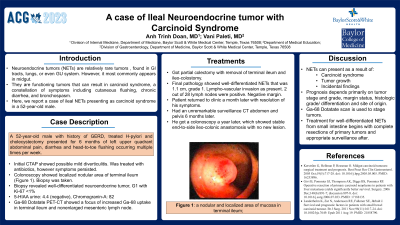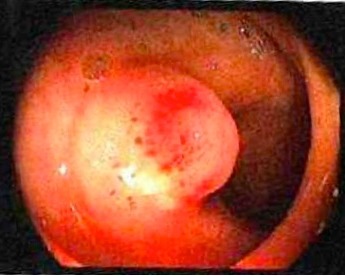Tuesday Poster Session
Category: Small Intestine
P4179 - Ileal Carcinoid With Carcinoid Syndrome
Tuesday, October 24, 2023
10:30 AM - 4:00 PM PT
Location: Exhibit Hall

Has Audio

Anh Trinh Doan, DO
Baylor Scott & White
Belton, TX
Presenting Author(s)
Anh Trinh Doan, DO1, Vani Paleti, MD2
1Baylor Scott & White, Belton, TX; 2BSWH, Killeen, TX
Introduction: Carcinoids are well-differentiated neuroendocrine tumors (NETs) originating mainly in digestive tracts, lungs, or in rarer cases, kidneys, or ovaries. Metastatic NETs from the midgut most often result in carcinoid syndrome, a constellation of symptoms including cutaneous flushing, chronic diarrhea, and bronchospasm. Here, we report a case of ileal carcinoid presenting as carcinoid syndrome in a 52-year-old male.
Case Description/Methods: A 52-year-old male presented for 2-3 years of left upper quadrant abdominal pain and head-to-toe flushing occurring multiple times per week. Labs were within normal limits. Colonoscopy showed a localized nodular area of mucosa in the terminal ileum (Figure 1). Pathologies revealed a low-grade well-differentiated neuroendocrine tumor, G1, Ki-67 less than 1%; depth of invasion was at least lower lamina propria of mucosa. CT w/wo contrast was unremarkable. 5 HIAA, urine 24 hours: 4.4 (negative). Ga-88 Dotatate PET-CT scan noted a focus of increased Ga-68 Dotatate uptake in the terminal ileum and nonenlarged mesenteric lymph node.
The patient got partial colectomy with the removal of terminal ileum and ileo-colostomy. Final pathology showed a well-differentiated neuroendocrine tumor that was 1.1cm, grade 1, involving the lamina propria and submucosa; lympho-vascular invasion was present; 2 out of 28 lymph nodes were positive for metastatic neuroendocrine tumor. The patient returned to the clinic a month later with the resolution of his symptoms. He then had a surveillance CT abdomen and pelvis 6 months after, which was unremarkable. He also got colonoscopy a year later, which showed stable end-to-side ileo-colonic anastomosis with no new lesion.
Discussion: NETs of the small intestine are most commonly found in the ileum within 60 cm of the ileocecal valve. Compared to other gastrointestinal NETs, midgut NETs are more prone to metastasize. However, their outcomes are most favorable. Patients in stage I and IIA have 95% 10-year survival rates. In patients with limited metastases, like in our case, local options such as complete resections, surgical debulking, and ablations can be considered. Given his small intestinal NETs, the recommended surveillance is a triple-phase CT scan or MRI of the abdomen and pelvis every 6 months for the first year and then annually for 10 years after surgery.

Disclosures:
Anh Trinh Doan, DO1, Vani Paleti, MD2. P4179 - Ileal Carcinoid With Carcinoid Syndrome, ACG 2023 Annual Scientific Meeting Abstracts. Vancouver, BC, Canada: American College of Gastroenterology.
1Baylor Scott & White, Belton, TX; 2BSWH, Killeen, TX
Introduction: Carcinoids are well-differentiated neuroendocrine tumors (NETs) originating mainly in digestive tracts, lungs, or in rarer cases, kidneys, or ovaries. Metastatic NETs from the midgut most often result in carcinoid syndrome, a constellation of symptoms including cutaneous flushing, chronic diarrhea, and bronchospasm. Here, we report a case of ileal carcinoid presenting as carcinoid syndrome in a 52-year-old male.
Case Description/Methods: A 52-year-old male presented for 2-3 years of left upper quadrant abdominal pain and head-to-toe flushing occurring multiple times per week. Labs were within normal limits. Colonoscopy showed a localized nodular area of mucosa in the terminal ileum (Figure 1). Pathologies revealed a low-grade well-differentiated neuroendocrine tumor, G1, Ki-67 less than 1%; depth of invasion was at least lower lamina propria of mucosa. CT w/wo contrast was unremarkable. 5 HIAA, urine 24 hours: 4.4 (negative). Ga-88 Dotatate PET-CT scan noted a focus of increased Ga-68 Dotatate uptake in the terminal ileum and nonenlarged mesenteric lymph node.
The patient got partial colectomy with the removal of terminal ileum and ileo-colostomy. Final pathology showed a well-differentiated neuroendocrine tumor that was 1.1cm, grade 1, involving the lamina propria and submucosa; lympho-vascular invasion was present; 2 out of 28 lymph nodes were positive for metastatic neuroendocrine tumor. The patient returned to the clinic a month later with the resolution of his symptoms. He then had a surveillance CT abdomen and pelvis 6 months after, which was unremarkable. He also got colonoscopy a year later, which showed stable end-to-side ileo-colonic anastomosis with no new lesion.
Discussion: NETs of the small intestine are most commonly found in the ileum within 60 cm of the ileocecal valve. Compared to other gastrointestinal NETs, midgut NETs are more prone to metastasize. However, their outcomes are most favorable. Patients in stage I and IIA have 95% 10-year survival rates. In patients with limited metastases, like in our case, local options such as complete resections, surgical debulking, and ablations can be considered. Given his small intestinal NETs, the recommended surveillance is a triple-phase CT scan or MRI of the abdomen and pelvis every 6 months for the first year and then annually for 10 years after surgery.

Figure: Figure 1: A localized area of mucosa in the terminal ileum was nodular.
Disclosures:
Anh Trinh Doan indicated no relevant financial relationships.
Vani Paleti indicated no relevant financial relationships.
Anh Trinh Doan, DO1, Vani Paleti, MD2. P4179 - Ileal Carcinoid With Carcinoid Syndrome, ACG 2023 Annual Scientific Meeting Abstracts. Vancouver, BC, Canada: American College of Gastroenterology.
